⭐ Do You Need Ductwork Sealing?
A home’s ductwork typically isn’t the first thing most homeowners think of when dealing with the mechanical system in their house.
But this network of supply and return air ducts plays a very important role in distributing warm or cool air throughout the house and keeping you, the homeowner, comfortable year-round.
No matter the climate, all homes in America use some mix of heating and cooling systems, either predominantly cooling in the south or heating up north.
This duct system should be maintained, as leaky ductwork can cause a spike in utility bills, excessive use of resources, and unwanted noise.
This article will outline three ways to make sure a duct system doesn’t leak, which will help you save money and stay comfortable.
Table of Contents
⭐ Problems Caused by Unsealed Ducts
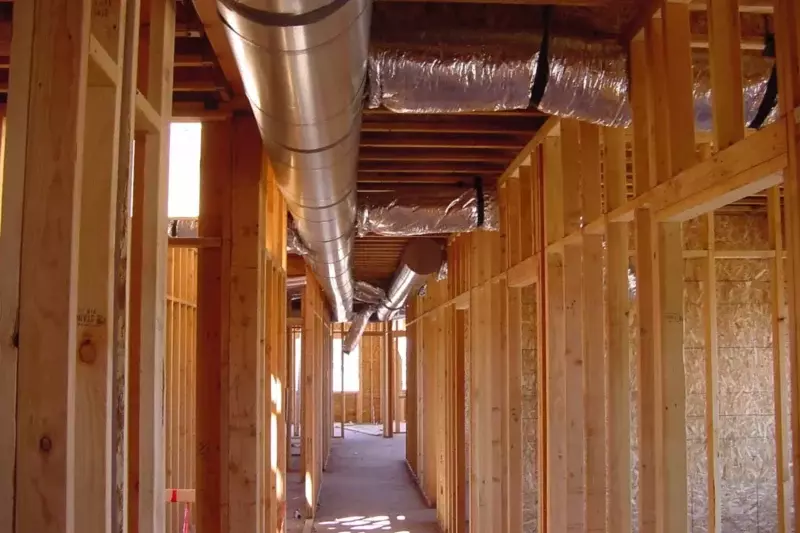
As you can imagine, all sorts of problems arise if you have air leaking from your ductwork.
These can come in the form of small leaks, big leaks, or hidden leaks.
Just remember, there IS a way to seal up all the leaks!
🔧 Keeping Dirty Air Out
On the supply side of your HVAC system, the air is being forced outwards through the air ducts.
But on the return side, the air is being forced back in towards the fan which can such dust and dirt particles inwards.
No duct system is immune to dust, but using aluminum foil tape or some sort of air duct sealing method is a very good way to prevent this dust from building up prematurely.
🔧 Lower Energy Bills
Forced air heating and cooling systems use resources like electricity, natural gas, propane, or oil to create cool or warm air.
On a leaky ductwork system, you can expect a lot of this conditioned air won’t make it back into the living space in your home, which is a waste of energy usage.
⭐ Benefits of Sealed Ducts
Improved HVAC Efficiency

Air duct sealing can have a very positive effect on the efficiency of your HVAC system.
When an air duct system is installed properly with tight joints and no leaks, the entire system runs smoother and lasts longer.
Could you imagine your furnace not putting out enough heat on a cold night simply because of some dust and dirt building up inside your ducts?
Related Reading: Ductwork Installation Guide For Homeowners
Better Air Quality

On HVAC systems with tight duct sealing, you can bet that building’s indoor air quality is better than average.
This is because, from day 1, there hasn’t been any opportunity for contamination in the HVAC system.
The best advice I always give customers is to simply change your furnace air filter every 3 months of run time, meaning not just running the furnace in the winter but also the air conditioning in the summer.
Both systems use the blower fan, which moves air through the air ducts almost year-round.
Cleaner Evaporator Coil
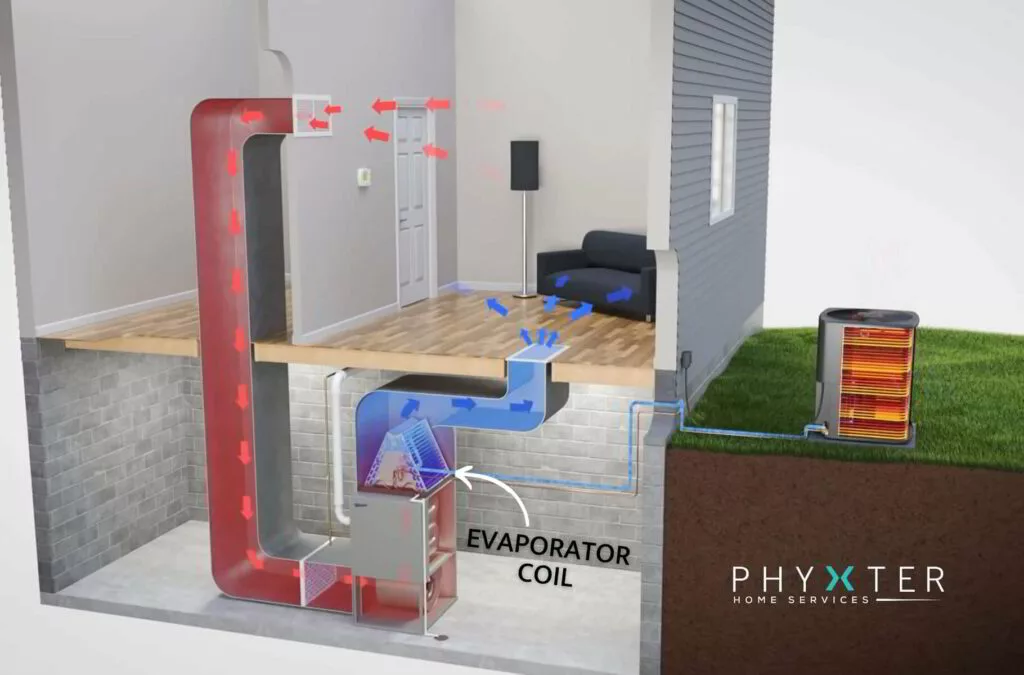
Stemming from better indoor air quality, the HVAC system’s evaporator coil will also accumulate less dust and lint over a longer period of time.
Your evaporator coil is responsible for creating conditioned air in your home.
Whether it’s cool air from your air conditioner or warm air from your heat pump, it plays a very important role and should be kept as clean as possible.
This is a huge deal because cleaning a dirty evaporator coil is an expensive and time-consuming job, not to mention the fact that a dirty coil will reduce the efficiency of your air conditioner or heat pump.
⭐ Small Duct Leaks Often Go Un-Noticed

This is especially true in an older home, or one you have lived in for a long time.
Any time I replace a furnace or air handler in a customer’s home, I always seal any gaps in the sheet metal transition I made, plus gaps in any other accessible ducts I can reach.
Customers usually fall into one of two categories, they are either amazed at the amount of air coming from their vents, or they’re not happy with new noises coming from their ducts.
Picture this scenario: A few staples have popped out of a piece of thermopan return air duct, meaning there is now a flap that is not attached to anything on three sides.
The old furnace moved less air so that flap waved a bit but didn’t make any noise.
Now with a new furnace moving much more air, this flap is repeatedly hitting the joist where it was originally attached, and all the homeowner can hear is smack, smack, smack every time the blower fan is running.
Fixing this large air leak involves opening the ceiling for access and stapling the pan back into its original position.
Now that example is on the extreme end of the spectrum, however, it illustrates the need to apply air duct sealing methods to HVAC systems that need it.
⭐ Duct Sealing Methods: Three Ways To Stop Air Leaks
Generally speaking, there are three ways to seal leaky ductwork.
The first one is quick and easy but doesn’t look all that great.
The second takes a bit of time and care but can have a very professional look once done.
And the third is a proprietary option from the company Aeroseal, which they can only do.
This is the most effective way to seal ducts, but it is also the most expensive and time-consuming.
Related Reading: Duct Repair: A Homeowners DIY Guide
Tin Tape, NOT Duct Tape
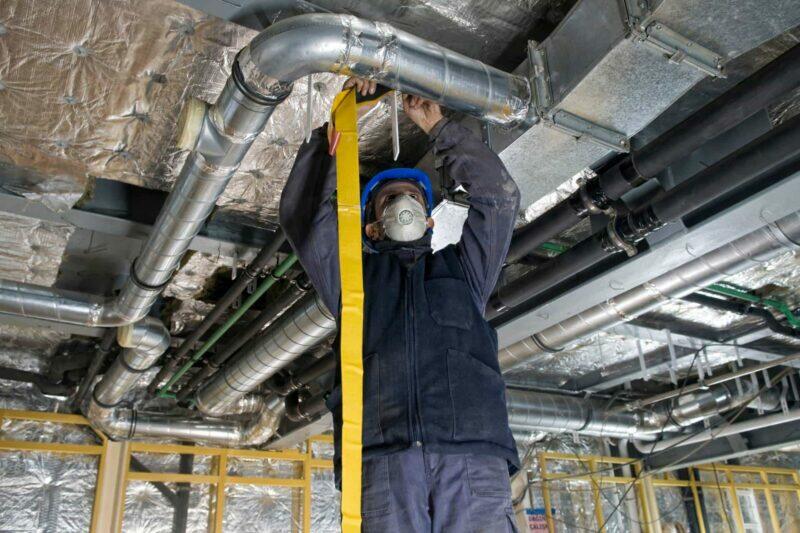
Option number one when dealing with leaky ducts is to simply grab a roll of tin tape or foil tape, depending on where you live, and wrap all unsealed duct connections, including each joint, corner gap, and seam.
This style of tin/foil tape is manufactured by a few different companies, and you really do want to get the best quality tape for the job.
First off, make sure there is a UL number on the packaging.
This stands for Underwriters Laboratory and means this product has been approved for duct sealing.
My recommendation is Nashua tin tape.
It peels off its backing easier, sticks better can be squeegeed smoother, and removed in one piece if the need arises.
Mastic Duct Sealant
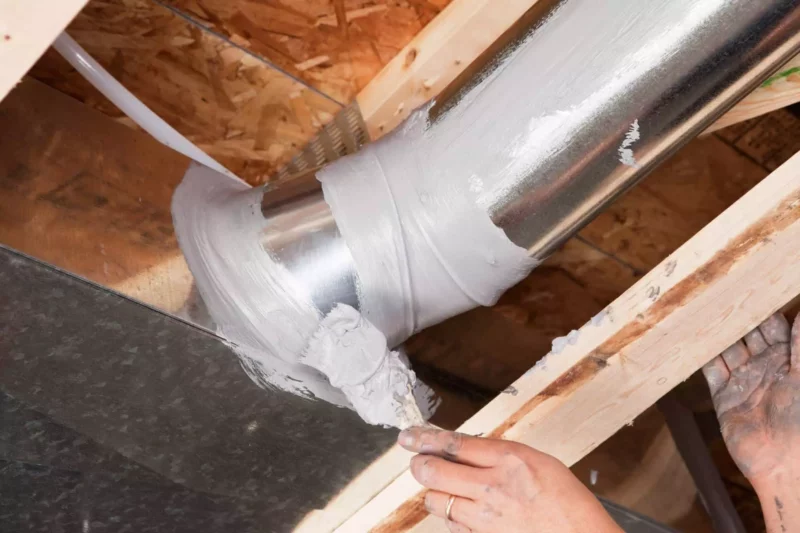
Option number two is to apply a duct sealing paste called Mastic sealant, which can also be called duct seal.
As with anything, there is a nice way and a not-so-nice way to apply this stuff.
If you want your HVAC system ducts to have a nice look after applying mastic duct sealant, I would recommend grabbing a roll of painter’s tape and making one full wrap around either side of the leaky area.
Then after using a paint brush to apply mastic all the way around, remove the tape, and you will have a perfect ring with nice, smooth edges.
Alternatively, you could skip the tape and just paint around the leaky area.
When it dries, you’ll be left with a blotchy grey area but no leaks!
One thing to remember is to wear gloves when applying duct mastic.
This is a paste and can get all over the place if you’re not careful.
Aeroseal Duct Sealing
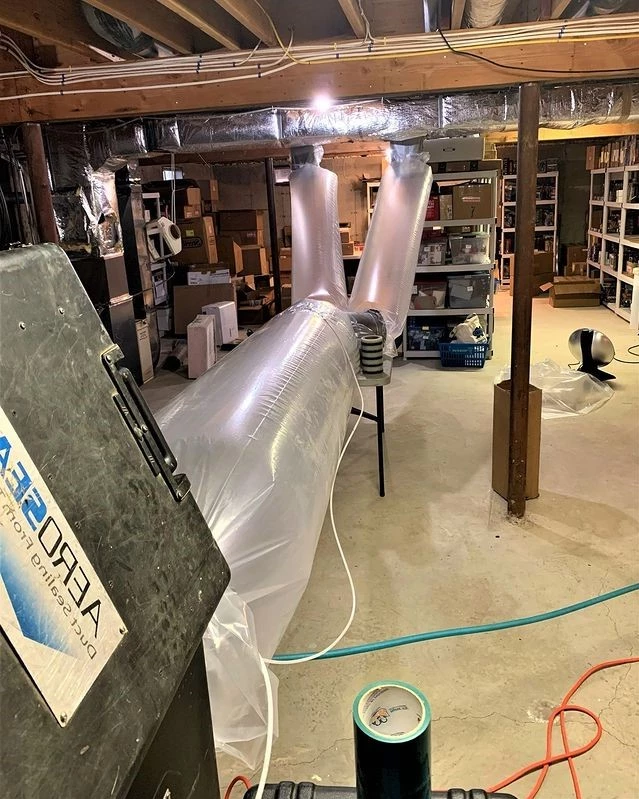
Option number three for duct sealing involves calling a company called Aeroseal.
They specialize in sealing ductwork from the inside out using a proprietary method invented specially for this industry.
The biggest advantage of Aeroseal is it can seal up any leak by injecting a liquid rubber sealant throughout the entire ductwork system.
This is done at one single point, saving you the hassle of removing drywall, searching for leaky ducts, and making repairs yourself.
You can find them online for more information by searching Aeroseal Duct Sealing.
🛑 Beware of Duct Tape

I know what you’re thinking, didn’t I just list duct tape as the first option when considering how to seal up leaky ductwork?
And you would be correct, I did.
However, there is a massive difference between foil tape and regular homeowner-quality duct tape, especially when it comes to sealing ducts.
First off, please, I beg you, do NOT use the classic grey, easy to rip duct tape from the drawer in your dad’s shop.
That stuff will fall off metal ductwork in a matter of days due to temperature fluctuations throughout the day and night.
Also, since regular duct tape has been around for quite a while in the home improvement industry, please take caution when removing any old tape from existing ductwork.
There are rumors this tape can contain asbestos, which is a health hazard when breathed in, so wear a face mask whenever dealing with old tape.
⭐ Conclusion

So the three ways of sealing your ductwork are tin tape (not duct tape), mastic duct sealant, and Aeroseal duct sealing.
Each has its own advantages and disadvantages.
However, this really is a case of ‘you get what you pay for.’
Sealing your ducts with tin tape or mastic is the cheapest and easiest if you have access to all the ducts in your house.
While Aeroseal can get to every leak in the ductwork system, but it can only be done by a certified professional from the company.
Remember to take precautions, too, such as not installing flexible ducts, using a good air filter, covering any tiny gaps, installing energy-efficient appliances, and ensuring all your vents are open.
These suggestions, coupled with leak-free ducts, will ensure your energy bills are lower, your air supply is steadier, and your ducts are cleaner.
Want to learn more about your home’s HVAC system? Feel free to check out our other HVAC articles!

